The concepts covered in this factsheet go beyond those seen in secondary school. It is intended as a supplement for those who are curious to learn more.
Roman society in Antiquity lasted for over 2,000 years. It began as a small village on the Italian peninsula. Within 1,000 years, this village had become a dominant mother country, imposing its vision on millions of people around the Mediterranean Sea. In 476, the Western Roman Empire disappeared, overwhelmed by ‘barbarian’ armies. The Eastern Roman Empire lasted another 1,000 years, until the Turks took Constantinople in 1453.
Roman civilisation was not always an empire. It was a monarchy, a republic and finally an empire. Around 800 BC, the central region of Italy was made up of several villages that lined the banks of a river called the Tiber. The Tiber is a river whose source is near Mount Fumaiolo and which flows into the Tyrrhenian Sea (part of the Mediterranean Sea). This region is very active in terms of trade, and has developed more rapidly than the other regions of Italy. To encourage and facilitate trade, the villages gradually grouped together, forming the city of Rome.
According to legend, twin brothers named Remus and Romulus, abandoned as babies, were saved by a female wolf who protected and nursed them until a shepherd came and adopted them. As adults, the two brothers decided to found their city (753 BC) by merging the few villages in the Tiber valley. During a violent dispute over which of the twins would control the city, Romulus killed his brother. Romulus thus gave his name to the city of Rome.
Only half a dozen kings ruled the city-state of Rome from 753 BC until the last king (Tarquin the Magnificent) in 509 BC. The first kings of Rome were not chosen for their lineage or origins, but rather for their virtues. Each king added at least one important feature to the city (walls, sewers, temples such as the Temple of Jupiter, draining of marshes, etc.). Despite these achievements, the Romans eventually opted for a republic (citizen participation in the management of power) rather than the monarchy and its tyrants.
At the beginning of the 5th century BC, Roman citizens rejected the monarchy, ousted the king and established the Roman Republic, which lasted from 509 BC to 27 BC. The king was replaced by two magistrates (often wealthy citizens), elected by the commoners or the people. They were to defend the interests of the people. A Senate was also created, made up of former magistrates. The Senate advised the two chief magistrates and enforced the laws. The assemblies of the commoners or the comitia elected the magistrates and passed the laws. In times of serious crisis, a magistrate may be appointed dictator, i.e. hold all powers for the duration of the crisis. The Romans, fearing a return to monarchy, created a separation of powers in their system of governance between the judiciary (the comitia, which passed laws) and the legislature (the magistrates, who proposed laws). As a result, magistrates' terms of office were limited to a single year and were not renewable.
At the beginning of the Roman Republican era, Rome was no more than a fairly well-defined city. But the strength of its army and the political and economic power it wielded in the region accelerated its expansion. Soon, it was annexing other regions of Italy before finally conquering external territories.
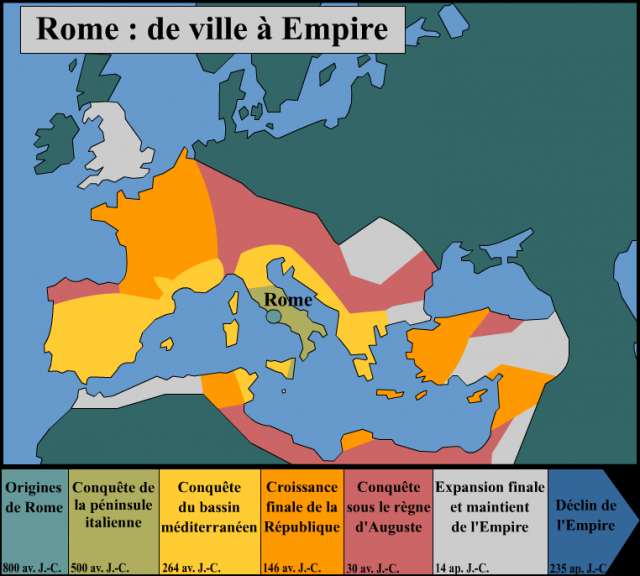
Roman expansion between 800 BC and 235 AD
Note : English image coming soon!
The powerful Roman army wanted to expand outside the Italian peninsula, and set its sights on Sicily, a large island just south of Roman territory. Around 300 BC, Rome decided to invade Sicily, but another civilisation just as powerful as itself had already gained a foothold there: Carthage. These people came from Africa, more precisely from a city called Carthage. At the time, they dominated almost the entire Mediterranean coast on the African side and part of Spain. For any people wishing to control the Mediterranean Sea, conquering Sicily was essential if they were to dominate the region commercially. The confrontation between these two great nations seemed inevitable: 264 BC marked the start of several confrontations between these two great armies, known as the Punic wars.
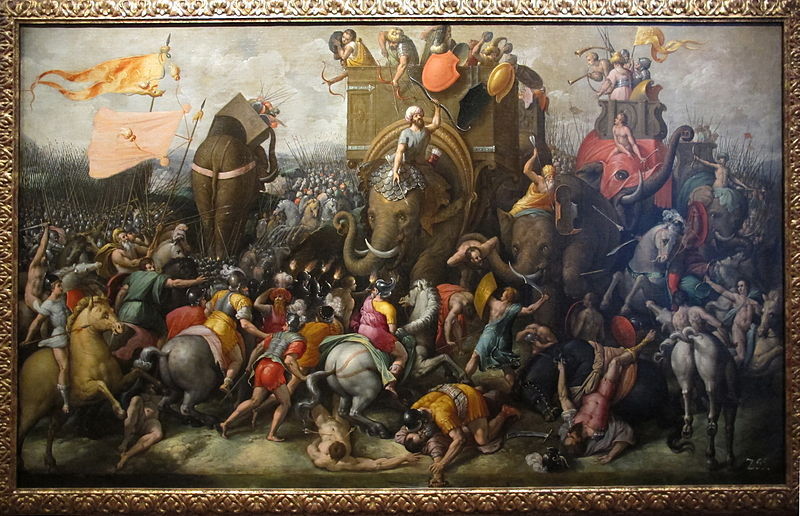
Hannibal and the Carthaginians with their elephants
Three great Punic wars pitted the two civilisations against each other over a period of almost 100 years. Hannibal, the leader of Carthage, even managed to smuggle 50,000 soldiers, horses and elephants across the Alps (the snow-capped mountain range separating France from Italy) so that he could attack the Romans from the north. Several years later, in 148 BC, Rome decided to attack Carthage and succeeded in destroying it. Gradually, Roman civilisation spread throughout the African coast, Spain and as far as Gaul (France) and Great Britain. One of the great generals who brought down Gaul was Julius Caesar. Ambitious, a great general with uncommon tactical intelligence and an enormous thirst for power, Julius Caesar had himself appointed dictator for life. He was assassinated by his own political entourage, who believed that Caesar wanted to make himself king, in 44 BC.
Roman society now extended over a territory too vast to be administered properly under a republican regime. Rome had become a huge mother country. The differences between the rich and the poor became more obvious, and the people could no longer pass laws as easily because they were so dispersed. The rules could no longer be applied in the same way everywhere without affecting the customs and traditions of each region.
When Julius Caesar died, his grand-nephew and adopted son, Octavian, assumed absolute power. He was both commander of the army and consul, although he was not elected by the magistrates. He called himself Emperor Octavian Augustus. He held all powers: civil, military and judicial. It was no longer the plebeians who passed the laws, but he himself. The emperor appointed councillors, senators and magistrates. Octavian Augustus even created the title of governor for the provinces he controlled from Rome. The Roman Republic no longer existed, giving way to the beginnings of the Roman Empire in 27 BC.
There were over a hundred Roman emperors from the beginning of the empire (27 BC) until its fall (476 AD). Here are some of the most important Roman emperors: Augustus, Caligula, Nero, Hadrian, Marcus Aurelius, Commodus, Theodosius 1st, Romulus Augustulus.
Rome imposed its culture throughout the Mediterranean basin, using Latin as its official language, building monuments, constructing buildings similar to those in the mother country, paved roads, aqueducts and cultivating vines, among other things.
Rome encouraged trade, such as the import of materials and goods, with its provinces. Thanks to its trading system, the Roman mother country became much richer. Paved roads usually led to the capital, to the detriment of the other provinces. These roads were also an advantage for the army, which had to move quickly from one region to another. A number of checkpoints were added to the roads, preventing goods from being stolen.
Rome became not only the economic but also the intellectual centre of the Roman Empire. Under Augustus, Rome's first public library was built. Virgil, the Roman poet, wrote an epic poem on Roman ideas, beliefs and traditions in a work called the Aeneid. Rome multiplied its libraries and museums in its regions as well as in its major cities. The cultivated citizen (his sharp mind) seemed to be a fundamental value of the Empire.
Under Julius Caesar and the Republic, Rome remained mainly influenced by Greek art, with its temples, Doric and Ionic columns, amphitheatres similar to those in Athens, and identical statues. However, from the beginning of the Roman Empire (under Augustus), the people were less interested in libraries and museums, but discovered a taste for spectacle (parades, gladiator fights, chariot races, etc.). Augustus made the spectacular, the Great Circus and its games, very popular.
Towards the end of Antiquity, the Roman Empire stretched from Great Britain, through Spain and the entire African coast bordering the Mediterranean Sea, to the plateaux of the Middle East (modern-day Syria). The Empire was vast and particularly difficult to manage: there were no longer enough Roman soldiers to guard such a vast frontier. Rome's military spending was now too high compared with the revenue it generated, and its citizens were being overtaxed. The government could no longer ensure the safety of its roads (as it once did in Rome) and many merchants had their goods looted. Farmers, who were also being looted in the fields, turned to the rich landowners to ensure their safety in exchange for their services (labour, tools, work on the landowner's property, etc.).
The territory was so vast that citizens in the west of the Empire did not have the same needs or experience the same reality as those living in the east of the Empire. This led to increasingly poor administration and the outbreak of several civil wars. For all these reasons, it became increasingly clear that the Empire would have to be split into two or more regions.
A civil war is an armed conflict between citizens of the same state.
On the death of Theodosius 1, in 395 AD, the Empire was divided between his two sons, Honorius (Western Empire) and Arcadius (Eastern Empire).

Eastern and Western Roman Empires
Note : English image coming soon.
Nomadic peoples from the north gradually penetrated the Western Roman Empire. To protect itself, Rome decided to collaborate with some of the foreign peoples already on its territory and thus protect the Empire from further barbarian invasions. But it was already too late: Rome no longer really controlled more than a fraction of its immense empire. Several peoples living outside the empire (whom the Romans called barbarians) took advantage of Rome's relative fragility to invade.
The nomadic peoples from the north, who refused to accept any advance by the Roman Empire, decided to attack the empire's borders. This great offensive movement is known as the Great Germanic Invasions or Barbarian Invasions. The peoples occupying the northern part of the empire shared similar languages and customs. These peoples were grouped together under the name of Germans, hence the Germanic name.
This Germanic people occupied the region around the Black Sea in the 2nd century BC. The Goths were originally from Sweden, and their language, Gothic, was very similar to Gutznik, a Swedish dialect. In 332, the Goths settled near the border of the Roman Empire and had to fight another people, the Huns, who drove them back into the territory of the Roman Empire. The Goths allied themselves with the Romans and, for a time, managed to hold back the Huns. The Goths understood the strategic importance of their presence on the frontier for the Romans: without them, other barbarian peoples could easily penetrate the territory of the empire. They decided to penetrate deeper into Roman territory. In 379, Emperor Theodosius 1 declared war on the Goths, but they crushed the Roman army.
These people were the western branch of the Goths. Like the Goths, they penetrated the empire and settled in the Balkans. In 410, the Visigoths went so far as to pillage the city of Rome. The Visigoths spread across Italy, France and Spain. They lost a major battle to the Franks, who forced them to leave Gaul (France) and settle further south in Spain.
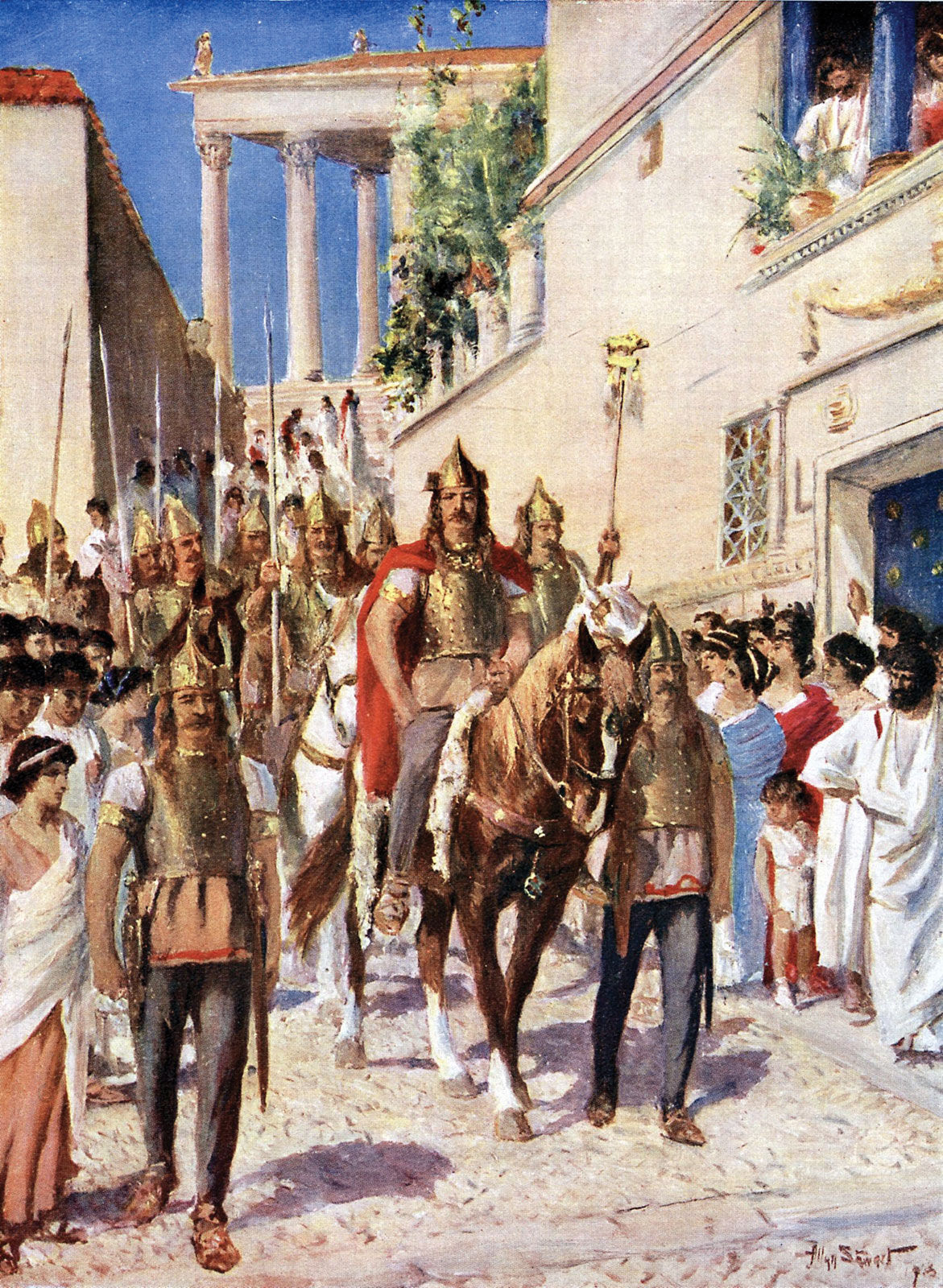
The Visigoths enter Rome
Around 450, several tribes settled west of the Rhine, a river in Roman Gaul. These barbarians were the first to settle permanently on the territory of the Empire. The various tribes that settled in Gaul, Belgium and the Netherlands formed a confederation, i.e. a union of organised groups, and called themselves the Franks (which means free in the Germanic language). The first king of the Franks was Clovis 1. The Romans attempted a series of assaults against the Franks, without any real success.
They then opted for a military agreement: the Franks were to help the Romans against the aggression of the Vandals (who were trying to penetrate the Roman Empire) in exchange for the right to settle in part of Gaul. The Franks survived the Roman Empire, which gradually lost its battles with the barbarian people.
These Germanic peoples, who came from northern Germany, settled on the island of Great Britain around the 5th century. The Angles gave their name to the future England and the English and hunted the Breton tribe from the island, which in turn settled on the western peninsula of Gaul (Brittany). However, many other tribes resisted the Anglo-Saxons on the island (Franks, Frisians, Jutes, etc.).
The Huns were not part of the family of Germanic peoples, but rather had multiple origins. They are thought to have had links with the Turks or other people. The Huns were nomadic (i.e. they travelled to find their food) and roamed the steppes of Central Asia on horseback. This gave them a speed and height advantage when fighting other tribes. Many tried to defend themselves unsuccessfully against the rapid and confusing attacks of the Huns (the Alans, the Goths, the Visigoths, etc.), who never attacked head-on, but rather surrounded the enemy, using fiery arrows and long sabres. The Huns roamed the vast plains, surviving by hunting and gathering, but above all grabbing the treasures looted from neighbouring peoples.
Nothing seemed to stop the Huns, who controlled almost all of Central Asia (Russia, Turkey and Eastern Europe). In 441, the leader Attila, son of the king of the Huns, demanded tribute (an income tax imposed by the victor and paid by the vanquished) from each subjugated region, enabling him to grow richer and found an empire: the Hun Empire. Attila, nicknamed God's scourge, murdered his own brother (who wanted to share the empire with him) and finally attacked the Eastern Roman Empire, without any real success. Around 450, the Eastern Empire counter-attacked, and the Hun people and Attila were forced to retreat. One by one, the Huns lost their regions to the Eastern Roman Empire. Attila died in 453, poisoned.
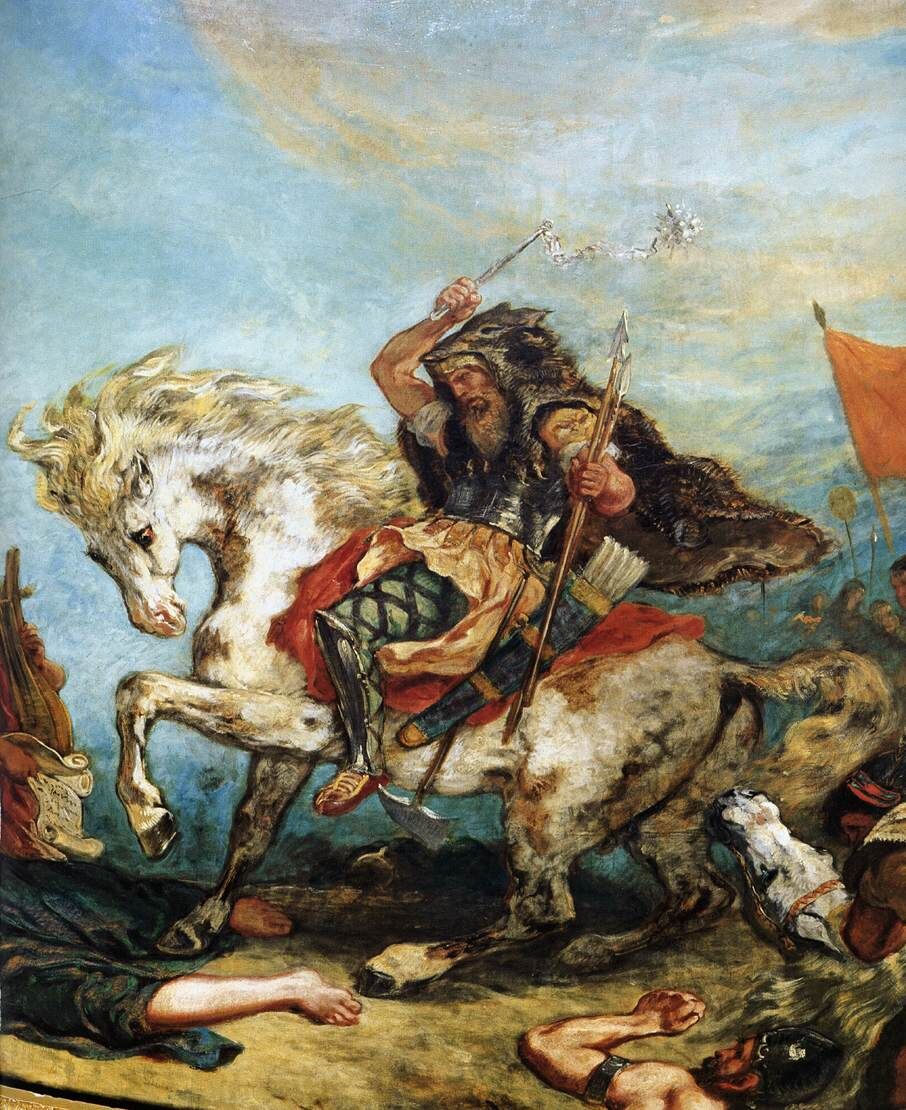
Attila, king of the Huns
While the Roman Empire was divided in two and the western part was being devastated by the Germanic peoples (the barbarians sacked the towns and ruined the economy), the eastern part (the Eastern Roman Empire) prospered. Rome had fallen (476) and the great Mediterranean city was now Constantinople. The Eastern Empire survived a thousand years longer than the Western Empire, until 1453.
Here are the main reasons why:
- Unlike its neighbouring empire, which remained sacked and ruined by barbarian invasions, the Eastern Roman Empire grew steadily richer thanks to the Greeks, great navigators, who controlled the sea trade. The empire took advantage of this trade to establish economic links with the African coast, Egypt and India.
- Emperors such as Arcadius, Constantine 1 (who gave his name to the city of Constantinople) and Comnenus strove to combat injustices between citizens from different regions of the Empire and thus prevent revolts. The population, in turn, esteemed the government and respected the institutions in place.
- The barbarians became less provocative; they had stopped being nomadic and were gradually settling on the banks of the Danube (the long river that runs through Europe). These newly settled people acted as bulwarks between other invading barbarians and the Empire in the East.
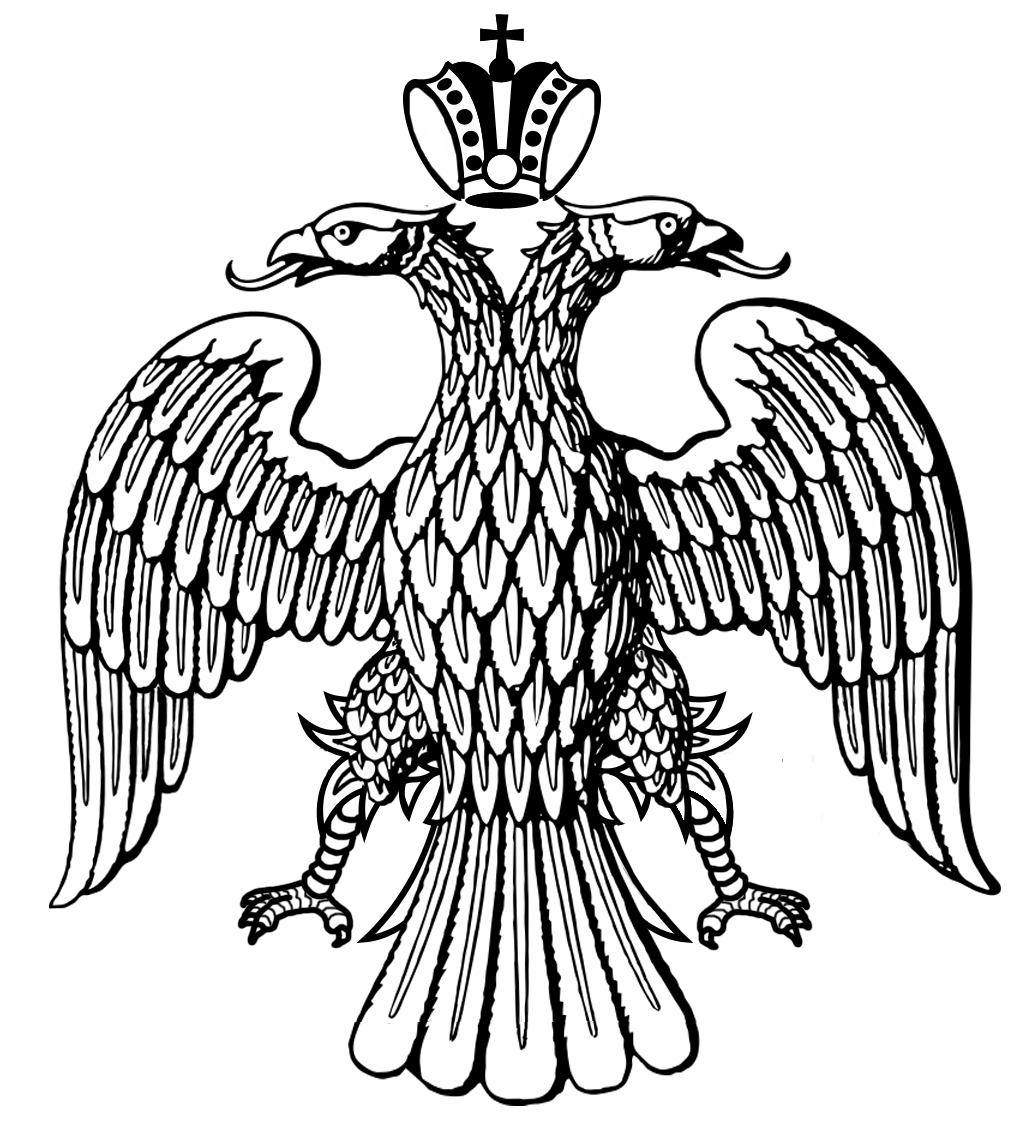
Eagle emblem of the Eastern Roman Empire